Basement support beams and posts are vital to your home’s foundation. Without these supports, your home would be unable to rest over your basement, and your structure would be uninhabitable. Once you’ve finished this article, you will know why these supports are essential and how to repair them if they start to fail.
What Are Basement Support Beams?
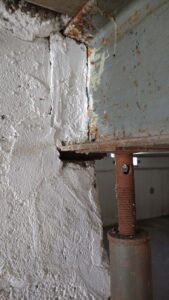
Basement support beams run across the top of your foundation and support your floor joists. These lateral beams can be made of wood or steel (I-beam) and are supported by posts that extend from your basement floor. If these beams start to deteriorate, chances are your first floor will begin to sag until there are noticeable dips and cracks.
If your basement support beams start to fail, your entire structure could collapse. This is why professionals always recommend performing annual basement inspections to ensure your support beams, joists, and posts are structurally stable.
If your basement support beam is made of wood, there’s a good chance it will bend over time if the posts supporting them are further than 10 feet apart. If the support beam is steel, it can bend if the support posts are spaced more than 12 feet apart (experts always recommend 10 feet just to be sure).
What Are Basement Support Posts?
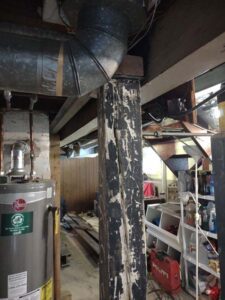
Basement support posts hold your lateral beams and transfer the weight into your slab. These steel or wooden posts can be an obvious eyesore or hidden inside a decorative column. Posts in older homes tend to crack and deteriorate due to deflection. This is when your post loses its structural integrity and slowly crumbles under the weight above. Once the weight becomes too much, your post will release the pressure to its sides and crack.
Most foundation repair professionals and structural engineers recommend repairing or replacing them as fast as you can once a crack exceeds the width of the post or beam. For example, if your six-inch wide post has an eight-inch crack, it’s considered a “failed post” and needs to be addressed immediately.
To summarize, your posts support your beams, and your beams support your joists. If one of these systems starts to fail, your entire structure’s stability will deteriorate.
Why Do Basement Support Beams And Posts Fail?
Basement support beams and posts usually fail because rot is spreading on wooden supports, rust is forming on steel supports, or your foundation is settling (and the structure is slipping out of alignment).
- Moisture – If moisture enters your basement, rot can form on your wooden supports and rust can form on steel supports. Once these structures lose their stability, you’ll need to replace them before anything collapses. Moisture can enter your basement using cove joints, unsealed egress windows, cracks, and any other gap water can squeeze through. To counter this, experts can seal cracks using epoxy, line the basement walls with an impermeable vapor barrier, and install a drain tile system with a sump pump to collect and eject intruding groundwater. Without a basement waterproofing system, moisture will build up in your foundation and stick to your supports, leading to wood rot and rust.
- Settlement – If the soil below your basement cannot support your home’s weight, your foundation can settle and sink. Once your foundation begins to shift, the posts holding your support beams will slip out of alignment and lose their stable position. To counter this, experts can lift your basement out of the weak soil and stabilize it using steel piers in a process called underpinning.
- Carpenter ants and termites – If a carpenter ant or termite colony finds its way inside your basement, your wooden beams and posts will be their first target. We recommend calling an exterminator before you call a foundation repair company.
- Natural disasters – If your home was recently impacted by an earthquake, flood, or other natural disaster, inspect your basement supports for any damage. If you notice anything major, call a foundation repair company immediately.
How To Repair Basement Support Beams And Posts
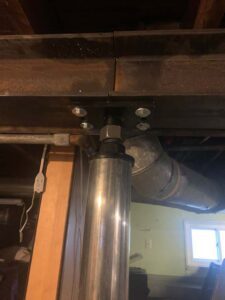
Most experts suggest replacing failing support beams and posts rather than simply repairing them. Depending on the damage, these supports might require different replacements. This could involve,
- Replacing the support beam.
- Replacing the support post.
- Replacing the support post footers.
There are “DIY” ways to patchwork a basement support beam or post. But no professional and experienced company will take on that liability since they consider these types of repairs as “band-aid” solutions. It’s much safer and more effective to replace any failing support altogether.
For example, most homeowners repair drywall cracks and uneven flooring as soon as they see them. If you raised a sagging I-beam, there would be some collateral damage to the finishings you’ve just repaired. If you notice drywall cracks or uneven floors above your basement, inspect your support beams and posts before you correct the cosmetic issues. Once professionals have replaced and stabilized your supports, you can repair any minor issues above.
Who Can Help?
If you live in Chicagoland and have a basement with support beams and posts, call The Real Seal. Even if you don’t notice any visible damage, a free inspection can help give you the peace of mind you need. If our inspectors find an issue, you can also feel relief now that the experts caught it before it got any worse. Call The Real Seal today and ask more about our other services, such as foundation waterproofing or concrete leveling.
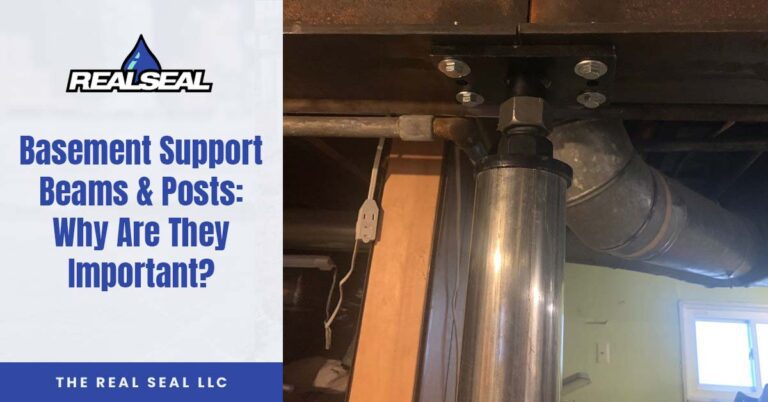
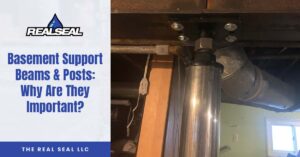





10 Responses
I have an 1850 farm house. I don’t want to raise the floor (because flooring/ceiling have already been put in to compensate for the sags), but I do want to give the old beams more support so they don’s sag (or worse) any more then that already have.
In adding jack posts to help, is there a generic rule of thumb for the distance between them?
Hi Chris!
Adding jack posts could help, but if your beam is sagging, the best thing is to replace the beam itself. The rule of thumb is 10ft between posts, but that can vary depending on the size of the I-Beam and footing used.
Wooden beams, once they sag, tend to not want to get back to straight. Try straightening a 2×4 that is bent and you will see what I am talking about.
Hello. I am lookingat adding a suporting beam under my home to help level a section. The curent floor joices are 2X10 16″ on center that span 14 feet. They have sag a bit. I am looking at adding a 12 foot trippled 2X6 and am wondering how fare aprt shoudl theh post be placed? I will need to pour concret. Clearnace from bottom of floor joices to ground is baout 2.5ft.
Thank you
Hi Joseph!
We always recommend 10′ spacing for the support posts at max. At a 14′ span for your joists, a bigger I-Beam won’t solve your problem. Putting 4″ supplemental beams in between the I-Beam and the foundation would be your best bet in helping the sag.
Hey,
So we had some settling issues due to a concrete porch(28Lx6-8Wx1.5-3F) that was stooped and not boxed out with footings. We had 8 piers and 4 wall anchors put in across the front and one pier in the back for the partial walkout. Once all the settling and movement seemed to be done, the floor where the beam is sank anywhere from 1/2”-3/4”. Our current post are not adjustable, so how do you determine the right size of post to replace each current post that is adjustable so we don’t put too much adjustment all at once? Current post are 13’6 apart.
Hi Jerrod,
It seems that there may be more going on here. There is a reason that sunk, and that reason needs to be addressed. Putting more posts won’t solve the issue. It sounds like it’s an underlying soil issue. You may need some soil support via Polyjacking or you may need some piers under the slab to hold it from sinking further. Best to consult a foundation repair contractor in your area to see what is really going on.
How important is it that beams are embedded into the basement walls? Can a meeting support beam not be embedded into a beam pocket and will be adequate?
Additionally, are adjustable jack posts adequate as permanent support posts? Thanks
Great question, Steven!
If you do not embed the beam into the basement wall, you should have a support right against the wall. You do not want your I-Beam to cantilever far, as it would not provide the best support above.
Adjustable jack posts from the big box stores are not adequate as permanent support posts. Best to get a proper rebar concrete footing and permanent support post. This does hold up the interior of your home, after all.
I have a house that was built in 1888 and has one 6 x 8’ inch main beam that is cracked beside the post that holding it up. Can I put a 6 x 6 post on each side of it to hold it up and can I cement it to a cement floor, I mean, put the wood in cement on a cement floor.
Hi Rose!
With a cracked beam that is that old, the best solution is replacing the entire beam. Remember that beam is what is holding the middle of your home up, and if the beam is cracked, it is likely weak in other areas as well. A new steel beam with supports and proper footings will help keep this historical home standing for many more years to come.